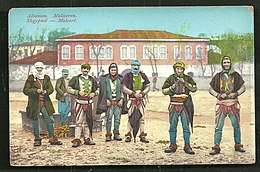Malonšići
Malonšići (in older forms: Malončići and Malonjšiki, Montenegrin Cyrillic: Малоншићи) was an Albanian tribe in southern Montenegro. They lived between modern Danilovgrad and Podgorica. By the late 16th century they were slavicized and later assimilated into Bjelopavlići.
| Part of a series on | ||||||||||||||
| Albanian tribes | ||||||||||||||
|---|---|---|---|---|---|---|---|---|---|---|---|---|---|---|
 | ||||||||||||||
|
Tribes and regions
|
||||||||||||||
|
Concepts |
||||||||||||||
|
Culture
|
||||||||||||||
History
The Malonšići were of Albanian origin. Their name is related to the Albanian word mal (mountain), a toponym and anthroponym which is very frequent among Albanian communities in modern Montenegro.[1] The locality of Malenza in their home territory has been connected by P. Šobajić to their name and has been interpreted as a compound mal and zi (black).[2] The tribe encompassed parts of what was later Zagarač, Komani and Bjelopavlići.[2] The area of the Malonšići is located in southern Danilovgrad Municipality and northern Podgorica municipality. The tribe lived in the basin of the Zeta, Sušica and Mareza rivers.
The Malonšići are first mentioned in 1411 in a report by the Republic of Ragusa in which together with Bjelopavlići, Ozrinići and Maznići they formed groups of bandits who raided trade caravans in the routes that connected Dalmatia with Serbia. In 1452 they were one of the tribes which supported Stefan Crnojević against Đurađ Branković and in 1455 along with Crnojević they swore fealty to Venice in the Vranjina Monastery.[3] Some of them after the conquest of the region by the Ottoman Empire fled their homeland and settled in Venetian territories, Kotor in particular. The tribe appears as part of the communities who paid taxes to Đurađ Crnojević who was an Ottoman vassal. In the defters of the Sanjak of Montenegro from 1521 to 1582/3 under Skender Bey Crnojević, they are listed as a distinct nahiya.[4] In the 1521 defter, their settlements were Vranići, Kosići, Bjeločani, Spuž, Bogišići, Radonjići, Grlov Kuk, Pavlovići, Vladovići, Lješevići, Jednoši, Lužnica Zur, Kalođurđevići and Zagreda and had a total of 150 households.[5] In the 1523 defter Malonšići was one of seven nahiye of the sanjak of Montenegro.[6] In the 1570 defter of the Montenegro Vilayet they were still a distinct community as a nahiya and had a total of 175 households and 12 baština which paid a 5,610 akçe in taxes.[4] Over time they were slavicized.[7] After 1582-83 they were no more a distinct community and became part of Bjelopavlići.[7]
References
- Eichler 2008, p. 718.
- Radusinović 1985, p. 359
- Djurdjev 1953, p. 42.
- Djurdjev 1953, p. 69.
- Djurdjev & Hadziosmanović 1973, p. 18.
- Djurdjev 1953, p. 59.
- Babić 1960, p. 161.
Sources
- Babić, Vladimir (1960). Историја народа Југославије. Просвета.CS1 maint: ref=harv (link)
- Djurdjev, Branislav; Hadziosmanović, Lamija. "DVA DEFTERA CRNE GORE IZ VREMENA SKENDER-BEGA CRNOJEVICA" (PDF). AKADEMIJA NAUKA I UMJETNOSTI BOSNE I HERCEGOVINE.
- Đurđev, Branislav (1953). Turska vlast u Crnoj Gori u XVI i XVII veku: prilog jednom nerešenom pitanju iz naše istorije. Svjetlost.CS1 maint: ref=harv (link)
- Eichler, Ernst; Hilty, Gerold, eds. (2008). Namenforschung / Name Studies / Les noms propres. 1. Halbband. de Gruyter.
- Radusinović, Pavle S. (1985). Naselja stare Crne Gore: poslednji dio. Posebna izdanja. Srpska akademija nauka i umetnosti.CS1 maint: ref=harv (link)